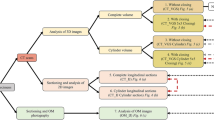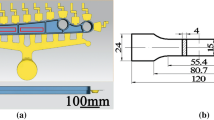The pores that occur during the casting process adversely affect the fatigue characteristics of the Al–Si alloys (silumins). The effect of casting pores under fatigue is associated with a number of factors, such as pore size, morphology, and position inside the cast part. Metallography can be used for the statistical characterization of pores. However, random two-dimensional sections through the pores fail to provide a reliable estimation of defect size without additional data analysis. This paper presents two experimental methods, namely X-ray computed tomography and metallography, which are used to characterize the size and morphology of the pores in the AlSi7Mg alloy casting. Three-dimensional data obtained by X-ray computed tomography were used to evaluate the criteria for determining the pore size based on metallographic measurements. The stress concentration resulting from the actual 3D morphology of pores was further investigated by the finite element method and compared with simplified 2D models of pores.








Similar content being viewed by others
References
Q. G. Wang, D. Apelian, and D. A. Lados, “Fatigue behavior of A356-T6 aluminum cast alloys. Part I. Effect of casting defects,” J. Light Metals, 1, 73–84 (2001).
M. J. Couper, A. E. Neeson, and J. R. Griffiths, “Casting defects and the fatigue behaviour of an aluminium casting alloy,” Fatigue Fract. Engng. Mater. Struct, 13, 213–27 (1990).
C. M. Sonsino and J. Ziese, “Fatigue strength and applications of cast aluminium alloys with different degrees of porosity,” Intern. J. Fatigue, 15, 75–84 (1993).
V. S. Rudnev, T. P. Yarovaya, P. M. Nedozorov, and Yu. N. Mansurov, “Wear-resistant oxide coatings on aluminum alloy formed in borate and silicate aqueous electrolytes by plasma electrolytic oxidation,” Prot. Met. Phys. Chem. Surf., 53, No. 3, 466–474 (2017).
Yu. N. Mansurov, Yu. A. Miklin, N. A. Miklin, and A. V. Nikol’skii, “Methods and equipment for breaking down gold-containing concentrates from lean ores and mining industry waste,” Metallurgis, 62, No. 1–2, 169–175 (2018).
B. Skallerud, T. Iveland, and G. Harkegard, “Fatigue life assessment of aluminum alloys with casting defects,” Eng. Fract. Mech., 44, 857–74 (1993).
A. A. Dabayeh, A. J. Berube, and T. H. Topper, “An experimental study of the effect of a flaw at a notch root on the fatigue life of cast Al 319,” Intern. J. Fatigue, 20, 517–530 (1998).
J.-Y. Buffiere, S. Savelli, P. H. Jouneau, E. Maire, and R. Fougeres, “Experimental study of porosity and its relation to fatigue mechanisms of model Al–Si7–Mg0.3 cast Al alloys,” Mater. Sci. Eng. A, 319, 115–126 (2001).
Yu. N. Mansurov, J. U. Rakhmonov, N. V. Letyagin, and A. S. Finogeyev, “Influence of impurity elements on the casting properties of Al–Mg based alloys,” Non-Ferr. Met., 44, No. 1, 24–29 (2018).
A. A. Aksenov, Yu. N. Mansurov, D. O. Ivanov, and D. S. Kadyrova, “Foam aluminium for small business in the Far East,” Tsvetn. Metally, No. 4, 81–85 (2017).
A. I. Bezrukikh, V. N. Baranov, I. L. Konstantinov, et al., “Modeling of casting technology of large-sized ingots from deformable aluminum alloys,” Int. J. Adv. Manuf. Techn., 120, No. 1–2, 761–780 (2022).
S. B. Sidelnikov, D. S. Voroshilov, M. M. Motkov, et al., “Investigation structure and properties of wire from the alloy of AL-REM system obtained with the application of casting in the electromagnetic mold, combined rolling-extruding, and drawing,” Int. J. Adv. Manuf. Techn., 114, No. 9–10, 2633–2649 (2021).
Yu. N. Mansurov, A. A. Aksenov, and V. P. Reva, “Influence of the chill-mold casting process on the structure and properties of aluminum alloys with eutectic constituents,” Tsvetn. Metally, No. 5, 77–81 (2018).
H. Mayer, M. Papakyriacou, B. Zettl, and S. E. Stanzl-Tschegg, “Influence of porosity on the fatigue limit of die cast magnesium and aluminum alloys,” Intern. J. Fatigue, 25, 245–256 (2003).
Y. Murakami, Metal Fatigue: Effects of Small Defects and Nonmetallic Inclusions, Elsevier Science (2002).
Y. X. Gao, J. Z. Yi, P. D. Lee, and T. C. Lindley, “The effect of porosity on the fatigue life of cast aluminium-silicon alloys,” Fatigue Fract Eng. Mater Struct., 27, 559 (2004).
Q. G. Wang and P. E. Jones, “Prediction of fatigue performance in aluminium shape casting containing defects,” Metal. Matls Trans B, 38, 615–621 (2007).
V. S. Rudnev, P. M. Nedozorov, T. P. Yarovaya, and Yu. N. Mansurov, “Local plasma and electrochemical oxygenating on the example of AMg5 (AMr5) alloy,” Tsvetn. Metally, No. 1, 59–64 (2017).
G. Nicoletto, P. Baicchi, and R. Koneþna, “Fatigue life prediction of AlSi alloys with casting defects,” in: Procs 2nd Fatigue Symp., Leoben (2008), pp. 2–11.
P. Powazka, et al., “Computed tomography – an alternative and complement to traditional metallographic investigations of porosity in cast aluminum,” in: Procs 2nd Fatigue Symp., Leoben (2008), pp. 51–66.
Yu. N. Mansurov, D. S. Kadyrova, and J. Rakhmonov, “Dependence of corrosion resistance for aluminum alloys with composition increased impurity content,” Metallurgist, 62, No. 11–12, 1181–1186 (2019).
Properties and Selection: Nonferrous Alloys and Special Purpose Materials, ASM Handbook. Vol. 2. USA, ASM Intern. (1990); https://doi.org/10.31399/asm.hb.v02.9781627081627.
E. Ferrie, J. Y. Buffiere, and W. Ludwig, “3D characterization of the nucleation of a short fatigue crack at a pore in a cast Al alloy using high resolution synchrotron microtomography,” Intern. J. Fatigue, 27, 1215 (2005).
A. A. Andreeva, S. Yu. Mansurov, D. V. Miklushevskiy, and Yu. N. Mansurov, “Model of formation of innovation process for large industrial enterprises,” Tsvetn. Metally, (3), 74–77 (2015).
D. V. Miklushevskiy, S. Y. Mansurov, T. N. Piterskaya, and Yu. N. Mansurov, “Economy and innovation management of universities,” Tsvetn. Metally, (9), 6–12 (2015).
E. S. Prusov, “Computed tomography for applications in three-dimensional materials science,” Fund. Issl., No. 5–2, 318–323 (2015).
A. Pierret, Y. Capowiez, L. Belzunces, and C. J. Moran, “3D reconstruction and quantification of macropores using X-ray computed tomography and image analysis,” Geoderma, 106, No. 3–4, 247–271 (2002).
H. Zhou, X. Peng, E. Perfect, T. Xiao, and G. Peng, “Effects of organic and inorganic fertilization on soil aggregation in an Ultisol as characterized by synchrotron-based X-ray micro-computed tomography,” Geoderma, 195–196, 23–30 (2013).
A. M. Petrovic, J. E. Siebert, and P. E. Rieke, “Soil bulk density analysis in three dimensions by computed tomographic scanning,” Soil Sci. Society USA J, 46, No. 3, 445–450 (1982).
S. J. Mooney, T. P. Pridmore, J. Helliwell, and M. J. Bennett, “Developing X-ray computed tomography to non-invasively image 3D root systems architecture in soil,” Plant Soil., 352, No. 1–2, 1–22 (2012).
S. A. Hall, M. Bornert, J. Desrues, Y. Pannier, N. Lenoir, G. Viggiani, and P. Bésuelle, “Discrete and continuum analysis of localised deformation in sand using X-ray μCT and volumetric digital image correlation,” Geotechnique, 60, No. 5, 315–322 (2010).
I. V. Yakimchuk, V. V. Abashkin, A. A. Chertova, and D. A. Korobkov, “Laboratory X-Ray Microtomgraphy of Sand Proppant Pack Under Stress,” in: 3rd Intern. Conf. on Tomography of Materials and Structures, Lund, Sweden, June 26–30 (2017).
I. V. Yakimchuk, I. V. Safonov, E. P. Serkova, et al., “Ceramic proppant microstructure characterization by x-ray microtomography,” in: Bruker Micro-CT User Meeting 2018, Ghent, Belgium, April 16–19 (2018).
I. G. Steward, Introduction to Fourier Optics [in Russian], Mir, Moscow (1985).
Author information
Authors and Affiliations
Corresponding author
Additional information
Translated from Metallurg, Vol. 67, No. 6, pp. 94–100, June, 2023.
Rights and permissions
Springer Nature or its licensor (e.g. a society or other partner) holds exclusive rights to this article under a publishing agreement with the author(s) or other rightsholder(s); author self-archiving of the accepted manuscript version of this article is solely governed by the terms of such publishing agreement and applicable law.
About this article
Cite this article
Rahimov, R.V., Abdullaev, B.A., Zhumabekov, B.S. et al. Comparison of X-Ray Computed Tomography and Metallography for Determination of Pore Size. Metallurgist 67, 839–848 (2023). https://doi.org/10.1007/s11015-023-01572-7
Received:
Revised:
Accepted:
Published:
Issue Date:
DOI: https://doi.org/10.1007/s11015-023-01572-7




